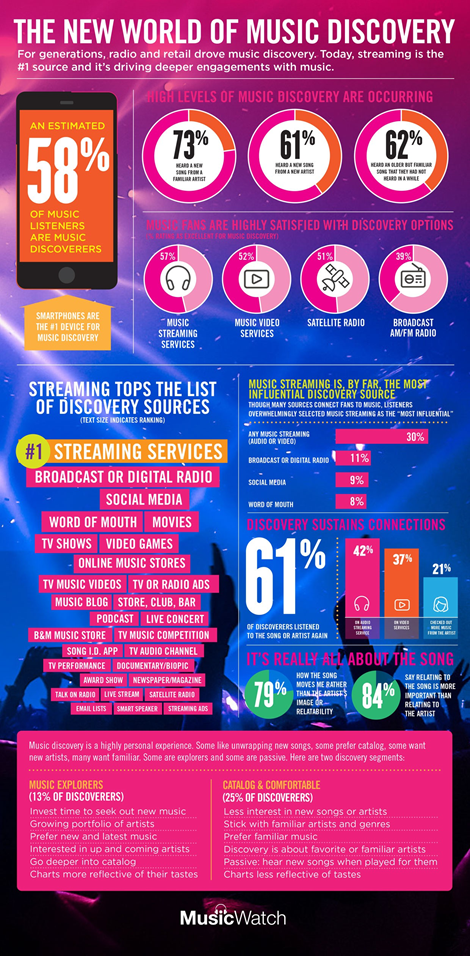The first music artist you discovered, that is. I remember distinctly three events. As a “toddler” sneaking down to the basement to see The Beatles on Ed Sullivan. Driving down the Meadowbrook Parkway after class on a cloudy day with the top down on the MG and hearing Roxanne played on WLIR for the first time. The Band wasn’t a new artist, but when I heard them on Sirius and realized I didn’t own their music, I took a sharp right into Borders on Jericho Turnpike and bought the “Best Of” CD. Music discovery enriches our lives.
For generations, radio, retail and recommendations drove music discovery. These “3 R’s” helped to create awareness of new music; curated by DJ’s, record store staff and our closest friends. By the late aughts the discovery scene began to shift, with digital downloads and nascent streaming models taking a greater role, CD sales waning, and increasing emphasis on re-discovery of catalog music.
Fifteen years ago MusicWatch collaborated with MusicBiz (then NARM) on a comprehensive study devoted to understanding music discovery. Broadcast radio was the top source of music discovery. We implored retailers to maintain CD selection and to segment their music customers more effectively in the face of emerging digital models. Music Watch’s most recent project on music discovery, conducted during May, 2021 in collaboration with DiMA and A2IM, surveyed 1000 music listeners in the US, covering their music listening habits and topics around the discovery experience. Check out the graphic below for some stats.
We learned that, from a fan perspective, music discovery has never been stronger. More touchpoints are available to fans for music discovery, and they are using them. They believe that streaming and social media have improved discovery. Discovery is more diverse; with appetite for new and catalog songs, and new and familiar artists. Fans are activating like never before, re-listening to newly found music, and diving deeper to make a connection with the artist. Dynamic features of the music services lubricate the discovery process.
Innovation has fueled music discovery The survey examined 35 potential sources for music discovery, asking which were helpful to music discovery. Two-thirds (63 percent) cited streaming, either audio or video services. That streaming topped the list was not necessarily a surprise. The takeaway is how many sources were considered useful. These ranged from the traditional (radio, retail, and recommendations) to emerging formats such as live streams, podcasts or smart speakers. The time we are spending watching video-on-demand helped place movies and TV shows high on the list. Artists and labels have an extensive portfolio of options for launching and promoting projects. Campaigns can be more multi-faceted than ever before, blending radio, streaming, social media, sync and other sources.
Music discovery is a highly personal experience Six out of ten music listeners experienced a music discovery moment during the prior six months. But how we experience discovery, and what we are looking for, can be highly personal. Music discovery is fragmented. It is not only about new music or emerging artists. Nearly half of respondents said they were satisfied hearing songs from their favorite artists, while 26 percent spend a lot of time seeking new songs and artists that they had not heard before. One in four “lean-in” and actively look for new music while they listen, but 44 percent are content just having new music curated for them. DSP’s have a unique opportunity to segment their subscriber base and tailor discovery experiences based on how listeners prefer to experience discovery. We see regular announcements from one streaming service or another highlighting a new innovation that seeks to target the audience that enjoys curated experiences, first pioneered by radio.
There are high levels of activation For discovery to have any value there must be a transaction with fans after the discovery event. The research showed that six in ten are going back to re-listen to the song that they discovered; 65 percent use an audio or video service to accomplish that.
These “re-streamers” also go deeper into the artist’s catalog, looking for lyrics, pictures or artist information. This activation can have direct financial impact for artists. Impressively, 42 percent look for tour information and 46 percent search for places to buy the music.
Streaming features supporting music discovery are highly effective Many streamers regularly take advantage of playlist features intended to highlight new music. Half say that personalized playlists do a good job of exposing them to new music; 82 percent like the mix of old and new music they are hearing. Playing similar songs after a listener selects something was a top-rated feature for aiding discovery. Innovation in streaming features isn’t just engineering for engineering sake- fans are embracing these features in their discovery journeys.
For years, the conversation was about which music format was #1 when it came to music discovery. In retrospect that was the wrong conversation. The thinking should be about how to serve fans and help discovery to thrive. Today, streaming is the most influential source, but there are a host of other touchpoints that can help artists to promote their music and help fans to find it. Once they do find it, they are hanging on like never before.
